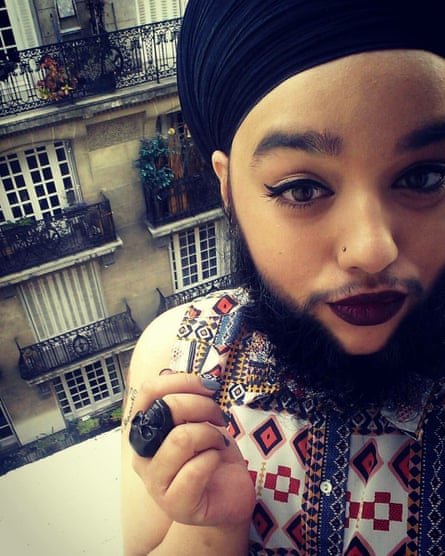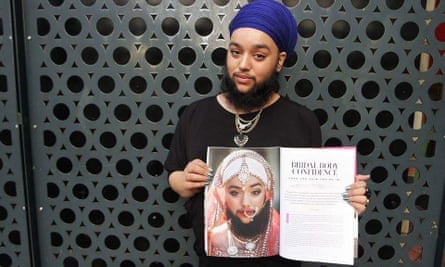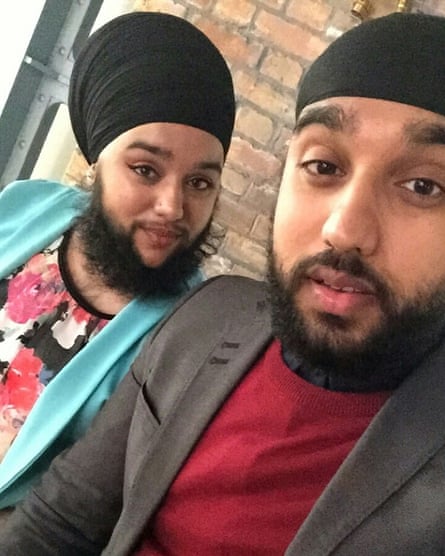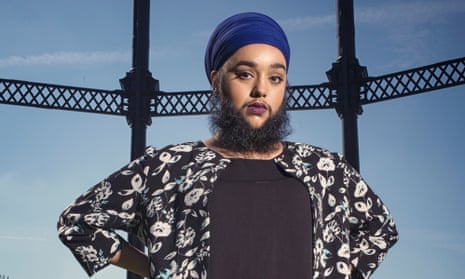Harnaam Kaur is in full flow when a young man passes our table. “He’s cute!” she grins, before her hand flies to her mouth. “Oh no, he heard me!” It’s a typically girlish reflex, made no less so by the soft, black hair her hand covers.
Kaur has worn her beard, a symptom of her polycystic ovaries, since she was 16. Today the thick, glossy facial hair is as much a part of her striking personal style as her electric-blue turban and perfectly executed winged eyeliner. It’s a combination that makes her look like a Mughal painting come to life – albeit one with purple lipstick and matching nails.
After enduring years of bullying, Kaur has turned herself into a body confidence advocate, model and Instagram star, upending gender norms and beauty standards as she goes. In arresting bridal fashion shoots she poses with flowers spilling from her beard, or as the most traditional of Indian brides in a red sari. A photograph of her recently hung in an exhibition at Somerset House in London, while in March she walked in her first fashion show for celebrity jeweller Marianna Harutunian. Now she is one of the new entries in Guinness World Records as the youngest woman to have a full beard.
When we meet, I am slightly embarrassed by the jolt of surprise I feel when I notice how well her natural hair suits her, framing her face into a delicate heart shape. It’s the gentlest reminder of how arbitrary our categories of femininity and masculinity can be.
Kaur’s pride in her image is everywhere – from the tote bag she carries, printed with tiny images of her face, to a tattooed portrait of herself on her leg. But as she has her picture taken in a nearby park, it’s impossible not to notice the covert whispers of nearby builders, and later as we have tea, the curious looks of other cafe customers. And I wonder how exhausting it must be to see the same startled responses every day.

After almost a decade of having a “lady beard”, as the 25-year-old calls it, Kaur can find people’s reactions amusing – she mimics the dropped jaws. “Since my story came out some people recognise me – but when they don’t they are confused. The reactions I get are so funny. They look at my eyes … then my beard … and then my boobs.” Other reactions, such as the shouted abuse or people openly taking pictures of her, are impossible to smile at, though.
Kaur’s composure was hard won. She hit puberty at 10 years old, and by 12 had been diagnosed with polycystic ovaries (for which she currently takes medication), causing thick facial hair. Her self-esteem was already fragile, she says, because as a chubby, brown girl she was taunted for being “fat” or a “Paki”.
Nothing, however, could have prepared her for the vicious bullying that followed. “They called me a ‘man’, ‘a beast’, an ‘ogre’, or just ‘fat’.” As a shy child, she had no way to fight back – although her parents frequently complained to her school and detentions and suspensions were given out. Kaur’s mother, anxious about the way society would treat her daughter, took her to a beauty salon.
“It was horrible,” Kaur says. “The wax went on, then the paper, then they pulled. I screamed so loudly the woman getting her hair done in the next door chair threw her magazine across the room. I was crying my eyes out. I did that every other day because my hair grew so fast – and shaved in between. They waxed it until my skin burned, going over the same patch again because some hairs were hard to get out. Then they would thread the raw skin, then pluck it.”
Instead of stopping the bullies, the hair removal only confirmed their view that it was something for Kaur to be ashamed of. “They called me everything under the sun, threatened me with knives and stabbed me with pens,” she says. By 15 she was skipping school, contemplating suicide, and self-harming. “I wanted to punish my body for looking this way. I wanted to hurt it.” One day, she emptied a bottle of pills into her hand. “It was my turning point,” she says simply. “I thought, ‘Fuck this shit!’ If the bullies are allowed to live, why shouldn’t I?”

It was the summer after her GCSEs, and at first, her decision to “just stop going to the beauty parlour” was easy. She spent the days playing in the park with her supportive younger brother. She also started wearing a turban. This was not, she is adamant, because she is religious (Kaur defines herself as “spiritual”) rather as a symbol of strength and a way to project pride in her identity.
Her confidence returned, but she still faced pressure from the Asian community to go back to removing her beard and moustache. “People would say: ‘You look like a man. You’ll never get married or get a job.” Yet she did not change her mind, even when she struggled to find work. “As soon as they see me, they say ‘No’, even if I was supposed to have an hour-and-a-half-long interview,” she says.
Today, she works as a freelance body confidence and anti-bullying advocate, and suggests that society can “feel threatened by empowered, strong women. When she breaks a stereotype she has to be put in her place.”
Far from hiding herself away, she now has a social media feed filled with new friends and pictures of her travels. She speaks with evangelical zeal about her determination not only to succeed in life, but to take other people with her. “One in five women have polycystic ovaries and lots of them approach me about how to counter the bullying and how to accept themselves,” she says. “I want them to say: ‘Well, Harnaam is on the catwalk, why not me?’ Bearded ladies were once laughed at – I want to break the mould.”
With all her newly found confidence I expect her to be optimistic about her love life, but Kaur is hesitant. A previous engagement was broken off in her early 20s. Her visibility on social media has made her a magnet for fetishists. “I block, delete and laugh,” she says. “I haven’t gone through all this to be someone’s object. A lot of people are shallow, so I think it would take a strong man, or woman, to say they want to be with me.”

She dismisses the idea that our sex organs should define us. “I don’t think I believe in gender. I want to know who said a vagina is for a woman and a penis is for a man, or pink is for a girl and blue is for a boy. I am sitting here with a vagina and boobs – and a big beautiful beard.” Her most recent photoshoot shows her and a bearded male model, both in skirts, and then trousers and open shirts, “to break down gender stereotypes”.
Wouldn’t it be better to reject the beauty and fashion industries completely? This, she thinks, is impossible and so she is, instead, “collaborating with as many magazines and doing as many TV appearances as I can, to show women that you don’t have to look a certain way to be happy”.
She is not calling for all women to put down their razors, though. “I live by the phrase ‘My body, my rules’. If keeping your hair makes you uncomfortable or depressed, then get rid of it; otherwise, if you’ve got it, rock it.”
I still wonder if some of the media attention – such as the Guinness World Records – plays into the sideshow slant of a woman with excess hair. But Kaur is having none of it. “As a child I would read it, and try to break the records. Being in it is about celebrating myself.” And she is equally confident that however arresting her image, it’s not the most important thing about her. “They can try to make a freakshow out of me, but my voice and my message is much stronger than that. I have power in my voice.”
Now Kaur would not be without her beard, even if she could be. “Before, I would have hidden in people’s shadows,” she says. “This has pushed me to my limits.”

Comments (…)
Sign in or create your Guardian account to join the discussion